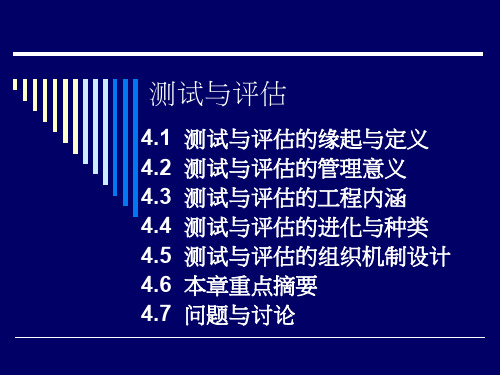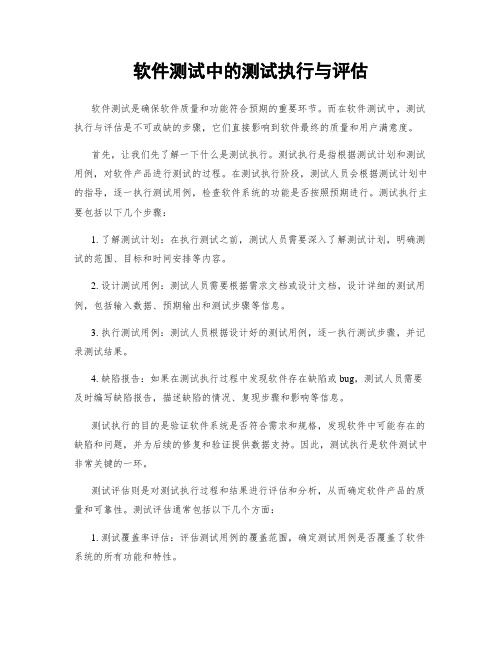测试与评估
心理咨询中的心理测试和评估

心理咨询中的心理测试和评估心理测试和评估在心理咨询中扮演着重要的角色。
它们是一种客观有效的方法,用于帮助心理咨询师了解客户的心理特征、问题和需求,从而为他们提供更准确、个性化的咨询服务。
本文将探讨心理测试和评估在心理咨询中的应用,并介绍几种常见的测试工具。
一、心理测试与心理评估的概念心理测试是通过一系列测量工具和程序,收集客观数据,以评估被测试个体的心理特征或状态。
心理评估则是利用心理测试的结果,结合临床观察、访谈和其他信息,对个体进行全面而系统的评估。
二、心理测试和评估的作用1. 了解客户的心理状态和特征:心理测试和评估可以帮助心理咨询师更全面、客观地了解客户的心理状态、人格特征、心理健康问题等方面的信息。
通过测试结果,咨询师可以针对个体的问题提供相应的咨询方案。
2. 个性化咨询服务:每个人的心理需求和问题都是独特的,通过心理测试和评估,咨询师可以更好地了解客户的需求,为其提供个性化的咨询服务,制定更具针对性的目标和计划。
3. 治疗效果评估:心理测试和评估可以用于评估心理治疗的效果。
通过反复测试,咨询师可以监测客户的进展和变化,并及时调整治疗策略,以达到更好的治疗效果。
三、常见的心理测试工具1. Minnesota多项人格测验(MMPI):MMPI是一种广泛应用的人格测试工具,用于评估个体的人格特征、心理健康状况以及潜在的心理问题。
它包含多个量表,涵盖了抑郁、焦虑、偏执等多个方面。
2. 康奈尔医院抑郁量表(CES-D):该量表是一种常用的测量抑郁症状的工具,用于评估个体的抑郁程度。
它包括20个项目,通过客观评估被测试者在情绪、睡眠、食欲和体重等方面的症状。
3. 应激反应自评量表(SRRS):SRRS是用来评估应激事件对个体心理压力水平的影响程度的工具。
通过评估个体在生活事件中的体验和应对反应,帮助咨询师了解个体的压力水平和应对能力。
四、心理测试和评估的限制与注意事项尽管心理测试和评估在心理咨询中具有重要的作用,但也存在一些限制和注意事项:1. 尽量选择科学有效的测试工具:心理测试的科学性和有效性对于确保咨询结果的准确性和可信度至关重要。
软件质量评估与测试

软件质量评估与测试软件质量评估与测试是软件开发过程中至关重要的环节。
它们的目标是确保软件产品符合用户的期望,并能够稳定、准确地执行各项功能。
本文将对软件质量评估与测试的重要性、方法和步骤进行探讨。
一、软件质量评估的重要性软件质量评估是评估软件产品符合用户需求和期望程度的过程。
它通过对软件进行全面的检查和测试,发现并改正其中的缺陷,从而提高软件的质量和可靠性。
软件质量评估的重要性主要体现在以下几个方面:1. 用户满意度:软件质量评估可以帮助开发人员了解用户的需求,并将其转化为可实施的功能。
通过评估软件的质量,可以确保用户得到满意的产品和服务。
2. 降低成本:及早发现和解决软件缺陷可以避免后期的修复成本。
软件质量评估有助于减少软件开发过程中的错误和缺陷,提高开发效率。
3. 提高可靠性:软件质量评估可以发现隐藏在软件中的缺陷和漏洞,从而保证软件的稳定性和可靠性。
这有助于避免因软件故障而引发的安全问题和损失。
二、软件质量评估的方法和步骤1. 需求分析:在软件质量评估过程中,首先需要对用户需求进行分析和明确。
这可以通过与用户进行沟通和讨论来获取。
需求分析阶段的目标是确保软件开发团队对用户需求的准确理解,并将其转化为软件的功能和特性。
2. 功能测试:功能测试是软件质量评估的重要组成部分。
它主要通过对软件功能的执行进行验证,以确定软件是否满足用户需求和规范要求。
在功能测试中,可以使用各种测试方法和技术,如单元测试、集成测试和系统测试。
3. 性能测试:性能测试是评估软件系统在不同负载和压力条件下的表现的一种方法。
通过性能测试,可以评估软件在不同情况下的响应时间、资源消耗和吞吐量等性能指标。
这有助于确保软件在实际使用中能够稳定、高效地运行。
4. 安全测试:安全测试是评估软件系统安全性和防御能力的一种方法。
它主要包括对软件的漏洞和弱点进行扫描和检测,以确定其是否容易受到攻击和入侵。
通过安全测试,可以帮助保护软件免受潜在的威胁和风险。
技术报告中的性能评估与测试方法

技术报告中的性能评估与测试方法性能评估与测试方法是技术报告中一个重要的方面。
在技术领域中,性能评估和测试方法对于验证和优化产品的性能至关重要。
本文将从不同角度对性能评估与测试方法展开详细论述。
一、性能评估的重要性性能评估是评估一个产品或系统在特定条件下的性能和可靠性的过程。
它可以帮助我们了解产品的潜力和局限,为我们的决策提供重要的依据。
通过性能评估,我们可以确定产品是否满足要求,是否需要进一步优化。
同时,性能评估也有助于提前发现和解决潜在的问题,提高产品质量和用户体验。
二、性能评估的目标和指标性能评估的目标是了解产品的性能表现,指标是用来量化产品性能的度量。
常见的性能评估指标包括响应时间、处理速度、并发能力、吞吐量等。
不同的产品有不同的性能指标,根据需求和使用场景选择适合的指标进行评估是非常关键的。
三、性能测试的步骤和方法性能测试是性能评估的一种方法,它通过模拟实际使用场景来测试产品的性能表现。
性能测试通常包括负载测试、压力测试、容量测试等。
在进行性能测试之前,我们需要确定测试目标、测试环境和测试数据,并制定测试计划。
在测试过程中,我们需要准确记录测试结果,并进行数据分析和报告撰写。
四、性能评估中的工具和技术性能评估中有许多工具和技术可以帮助我们进行评估和测试。
例如,性能监控工具可以帮助我们收集和分析产品的运行数据,性能测试工具可以帮助我们模拟真实场景进行测试。
此外,还有一些性能优化技术可以帮助我们提升产品的性能表现,例如缓存、并行处理等。
五、性能评估的挑战和解决方法性能评估中会面临一些挑战,例如多样性场景的模拟、大规模数据的处理等。
针对这些挑战,我们可以采用一些解决方法。
例如,我们可以使用自动化测试工具来提高测试效率和一致性;我们可以使用仿真和建模技术来模拟多样性场景;我们可以采用分布式计算和存储技术来处理大规模数据。
六、性能评估的应用和展望性能评估在技术领域中有广泛的应用。
它不仅可以应用于软件系统、硬件设备的评估,还可以应用于网络、数据库、云计算等领域。
计算机硬件性能评估与测试

计算机硬件性能评估与测试计算机硬件性能评估与测试是指对计算机硬件的各项指标进行测量、测试与分析,以评估其性能和可靠性。
这项工作对于硬件研发、生产和用户使用都具有重要意义,可以帮助人们选择和购买最适合的计算机硬件产品,提高计算机的工作效率和性能。
一、性能评估的重要性计算机硬件的性能评估是保证计算机正常运行和提高工作效率的基础。
通过性能评估,可以了解计算机硬件在不同条件下的工作状态,评估其在处理数据、图像、声音等各种应用中的性能表现。
同时,性能评估还可以发现和解决硬件存在的问题和隐患,提供改进的依据。
二、性能评估的指标1. CPU性能:CPU是计算机的“大脑”,其性能指标包括主频、缓存容量、乘法器效率、浮点运算能力等。
2. 内存性能:内存是计算机存储数据的空间,其性能指标包括容量、传输速度、延迟等。
3. 硬盘性能:硬盘是计算机永久存储数据的介质,其性能指标包括容量、读写速度、响应时间等。
4. 显卡性能:显卡是计算机图形处理的核心,其性能指标包括显存容量、带宽、像素填充率等。
5. 网络性能:网络是计算机之间进行信息交流的通道,其性能指标包括传输速度、延迟、丢包率等。
三、性能评估的方法1. 基准测试:通过运行一系列固定测试任务,测量计算机硬件在不同条件下的性能表现,并将结果与已知的基准值进行对比。
常用的基准测试软件有PassMark、Geekbench等。
2. 负载测试:通过模拟实际使用场景,给计算机硬件施加不断变化的负载,观察其在高强度工作状态下的性能表现。
常用的负载测试工具有Prime95、FurMark等。
3. 真实场景测试:将计算机硬件嵌入到实际使用环境中,运行各种真实任务,并通过监测硬件的功耗、温度等指标,评估其在真实场景下的性能和可靠性。
四、性能测试的注意事项1. 测试环境的稳定:测试前需确保测试环境的稳定性,避免外部因素对测试结果产生影响。
2. 测试样本的选择:测试样本应具有代表性,能够反映计算机的真实使用情况。
测试效果评估如何评估测试的质量和价值

测试效果评估如何评估测试的质量和价值测试是软件开发生命周期中不可或缺的一环,它可以确保软件的质量、发现潜在的问题和缺陷。
然而,测试本身也需要评估其效果,以确定测试的质量和价值。
本文将探讨如何评估测试的质量和价值,以提高测试的效果。
一、定义测试效果评估指标测试效果评估的第一步是定义适当的评估指标。
评估指标应与测试目标和需求相匹配,并能够客观、准确地衡量测试的质量和价值。
以下是一些常见的测试效果评估指标:1. 缺陷发现率:缺陷发现率是指在测试过程中发现的缺陷数量与测试用例执行总数之比。
较高的缺陷发现率意味着测试的质量更好。
2. 缺陷修复率:缺陷修复率是指在缺陷被发现后,开发团队及时修复并进行验证的比例。
较高的缺陷修复率意味着测试的效果更好。
3. 测试覆盖率:测试覆盖率是指测试用例覆盖的代码、功能或需求的比例。
较高的测试覆盖率意味着测试的全面性更高。
4. 执行时间和资源消耗:评估测试的效果还需要考虑测试执行的时间和所消耗的资源。
较短的执行时间和较少的资源消耗意味着测试的效率更高。
二、采集数据并进行分析评估测试的质量和价值需要采集相关的数据,并进行综合分析。
测试执行过程中,可以记录每个测试用例的执行结果、缺陷信息、执行时间等数据。
通过对这些数据进行统计和分析,可以得出以下结论:1. 缺陷的分布及严重程度:分析缺陷的分布情况和严重程度,可以确定测试是否覆盖了更容易出现问题的部分,并优先处理严重的缺陷。
2. 测试用例的覆盖情况:分析测试用例的覆盖情况,可以判断测试是否足够全面,并补充相应的测试用例以提高测试的覆盖率。
3. 测试执行时间和资源消耗:对测试执行时间和资源消耗进行分析,可以找到测试执行过程中的瓶颈,提高测试的效率和资源利用率。
三、定期进行评估和改进测试效果评估应该是一个持续的过程,而不是一次性的活动。
定期对测试的质量和价值进行评估,并根据评估结果采取相应的改进措施。
以下是一些常见的改进措施:1. 优化测试用例设计:根据评估结果,改进测试用例设计,增加对易出现缺陷的部分的覆盖,提高测试的效果。
测试与评估

一、确认设计缺失与降低研制风险 测试与评估是研发工程技术人员,用来发觉问 题与消除研发风险的手段,因为科技性的产品 研发,往往涉及到庞大人力、物力与财力的投 入,如果产品研发过程中没有发现问题缺陷, 则产品一旦量产或进入市面之后,必然对企业 的经营产生绝对的影响,很多高科技产业的案 例可以说明此一严重性。
四、生产前模型测试评估(Preproduction Prototype) 「生产前模型」的测试评估,是产品从研发阶 段正式转型,进入量产前的一个关键性的验证 作业。
4.5 测试与评估的组织机制设计
组织如何进行这个掌握项目生杀大权的机制? 如何规划产品研发项目的测评?由谁来公正客 观的执行?是谁才具有评估项目继续执行的决 策权等问题?都是探讨「测试与评估」组织机 制设计时,必须掌握的要点。
四、测试与评估的装备采购 「测试与评估」执行过程中的最后一道关键工 作,就是必须具备仿真的测试环境,否则测试 结果容易失去真实性。其中,测试装备的获得, 为最关键的考虑。因为若没有测试装备,那么 测试评估就不易进行,于是即便先前的准备工 作做的再好,也于事无补。
1.美国半导体产业在美国的由盛而衰,最后 又能在1990年代超越日本的最大原因,即在 于美国产品开发小组,能够设计出功能齐全 的测试设备,快速、大量、并精确的测试整 个半导体的开发过程,所以才能使美国的试 生产量远远高于日本与韩国(Iansiti, 1997)。
测试与评估
4.1 测试与评估的缘起与定义 4.2 测试与评估的管理意义 4.3 测试与评估的工程内涵 4.4 测试与评估的进化与种类 4.5 测试与评估的组织机制设计 4.6 本章重点摘要 4.7 问题与讨论
「测试与评估(Test and Evaluation, T&E)」 是「产品获得生命周期(Product Acquisitions Life Cycle)」过程中的一个管理作业活动,扮 演产品开发项目全寿期的把关角色。
如何进行产品可靠性评估与测试

如何进行产品可靠性评估与测试产品可靠性评估与测试是保证产品质量和用户满意度的关键步骤。
它能够检测产品在使用过程中可能出现的故障和缺陷,以便及时修复和改进。
本文将介绍如何进行产品可靠性评估与测试的步骤和方法,并说明其重要性。
进行产品可靠性评估与测试的第一步是确定评估指标。
可靠性评估的指标可以包括故障率、失效模式与效果分析(FMEA)、故障树分析(FTA)等。
根据产品的特点和使用环境,选择适合的评估指标是很重要的。
例如,对于关键性高的产品,故障率和可靠性需求会更加严格。
第二步是设计测试方案。
测试方案应包括测试目标、测试方法和测试流程。
测试目标是指明进行测试的目的,例如确定产品的可靠性水平或发现可能的故障。
测试方法可以包括实验室测试和现场测试等,具体取决于产品的特点和使用环境。
测试流程应详细描述每个测试步骤和所需的测试设备或工具。
在执行测试方案之前,需要准备好测试环境和测试设备。
为了评估产品的可靠性,测试环境应尽可能接近实际使用环境。
例如,测试温度、湿度和振动等条件应符合产品的使用要求。
同时,测试设备也应具备测试所需的准确性、可重复性和可靠性。
执行测试过程时,应按照测试方案的要求逐步进行测试。
测试过程中应确保数据的准确性和完整性,记录下每个测试步骤的结果和问题。
对于测试中发现的问题,应及时进行记录和分析,以便后续改进和修复。
根据测试结果,可以对产品的可靠性进行评估和分析。
评估的方法可以包括故障率分析、生存性分析和可靠度预测等。
这些分析可以为产品的改进提供依据,有助于提高产品的可靠性和性能。
根据评估和测试结果,可以对产品进行改进和修复。
改进的措施可以包括优化设计、更换材料和改进生产工艺等。
修复的措施可以包括修复故障和缺陷、提供产品更新和维修支持等。
通过改进和修复,可以提高产品的可靠性和质量,满足用户的需求和期望。
产品可靠性评估与测试的重要性不可忽视。
它可以帮助制造商减少产品退回和维修的成本,提高用户满意度和品牌声誉。
软件测试评估与评价

软件测试评估与评价软件测试是确保软件质量的重要环节,而软件测试评估与评价则是检验测试工作的有效性和质量的过程。
本文将探讨软件测试评估与评价的方法和指标,以及其在软件开发生命周期中的重要性。
一、软件测试评估与评价的定义软件测试评估与评价是通过对软件测试活动进行系统性分析与检查,以确定测试工作的有效性和质量。
它旨在评估测试过程中所用的方法、技术和工具,以及测试结果的准确性和可靠性。
二、软件测试评估与评价的方法1. 测试活动评估评估测试活动包括对测试过程中所用的方法、技术和工具进行评估,以确定其在测试活动中的效果和质量。
评估的指标可以包括测试用例的设计覆盖率、缺陷发现率、测试工作量等。
2. 测试结果评价评价测试结果是对软件测试过程中发现的缺陷进行定性和定量分析,以确定缺陷的严重性和紧急性。
评价的指标可以包括缺陷的数量、重要性、修复进度等。
3. 测试团队评估评估测试团队是对测试团队的组织结构、工作分配和沟通协作进行评估,以确定团队在软件测试过程中的协同效能和质量水平。
评估的指标可以包括团队成员的专业技能、合作能力和问题解决能力等。
三、软件测试评估与评价的指标1. 完整性完整性指标评估测试过程是否覆盖了所有的功能和需求,以达到对软件的全面测试。
评价完整性需要综合考虑测试用例设计的覆盖率、需求追踪的准确性以及测试计划和策略的综合性能。
2. 效率效率指标评估测试活动的时间和资源消耗是否合理,以达到测试的及时性和成本控制。
评价效率需要综合考虑测试用例的设计复杂度、测试工作量和测试执行的效率。
3. 准确性准确性指标评估测试结果的正确性和可靠性,以达到对软件缺陷的准确判断和修复控制。
评价准确性需要综合考虑缺陷的定位准确性、缺陷的关联性和测试结果的一致性。
四、软件测试评估与评价的重要性1. 提高测试质量通过评估与评价,可以及时发现测试过程中的问题和不足,从而改进测试方法与策略,提高测试质量和效果。
2. 控制测试成本评估与评价可以帮助评估测试活动的效率和资源消耗,从而控制测试成本,优化测试资源的分配和利用。
电子产品的测试与质量评估方法

电子产品的测试与质量评估方法电子产品作为现代社会不可或缺的一部分,其质量的良好与否直接影响到用户的使用体验和产品的市场竞争力。
为了确保电子产品的功能稳定、性能可靠以及符合相关的安全标准,各种测试与质量评估方法被广泛应用。
本文将介绍一些常见的电子产品测试与质量评估方法。
一、环境测试环境测试是为了模拟实际使用环境对电子产品的影响而进行的测试。
其中包括温度测试、湿度测试、振动测试、冲击测试等。
温度测试主要是通过将电子产品暴露在不同的温度条件下,以检验其在极端温度环境下的工作能力;湿度测试用于评估电子产品在潮湿环境下的耐用性;振动测试和冲击测试则用于模拟电子产品在运输和使用过程中的震动和冲击情况,以评估其结构的牢固性和性能的稳定性。
二、功能测试功能测试是评估电子产品各项功能是否能正常工作的一种测试方法。
通过对电子产品的各项功能进行综合测试,可以验证其是否满足设计要求。
功能测试包括输入输出测试、存储测试、通信测试、界面测试等。
输入输出测试主要是验证电子产品的输入输出接口是否能够正常工作;存储测试则是测试设备的存储器是否能够正常读写数据;通信测试用于检测电子产品在不同通信环境下的可靠性;界面测试则是验证设备的各个操作界面是否易用、功能是否完善。
三、可靠性测试可靠性测试是为了评估电子产品在长时间使用时的稳定性和可靠性。
主要包括寿命测试、可靠性评估、故障模式和影响分析等。
寿命测试通过对电子产品进行高负荷的长时间工作,以模拟真实使用环境下的情况,验证其在长时间运行中是否会出现性能下降或失效;可靠性评估则是通过统计方法对电子产品在使用寿命内的故障率进行评估,以指导产品质量改进;故障模式和影响分析则是对故障原因进行分析和评估,以制定相应的维修和改进措施。
四、安全性测试安全性测试是为了评估电子产品在使用过程中对用户安全是否存在潜在风险的一种测试方法。
其中包括电磁兼容测试、安全认证测试、防护性能测试等。
电磁兼容测试用于评估电子产品在电磁干扰环境下的抗干扰能力;安全认证测试是为了验证电子产品是否符合相关的安全标准和法规;防护性能测试主要是对电子产品的外壳和封装进行测试,以评估其对用户的防护性能。
电路测试与性能评估方法

电路测试与性能评估方法电路测试与性能评估在电子领域中起着至关重要的作用。
无论是在电路设计、生产制造还是故障排除过程中,都需要可靠的测试方法和准确的性能评估指标。
本文将介绍几种常见的电路测试方法和性能评估方法,并分析它们的优缺点,以帮助读者更好地了解和应用。
一、电路测试方法1. 静态测试法静态测试法是最基本、最常用的测试方法之一。
它通过对电路中的元件进行电阻、电容、电感等参数的直接测量,以验证电路的正常工作状态。
该方法操作简单、成本低,适用于简单电路和初步故障排查。
2. 动态测试法动态测试法通过对电路中的信号进行控制、激励和观测,以验证电路在不同工作条件下的性能。
例如,可以通过施加不同的输入电压来检测输出信号的波形、频率响应等,以评估电路的稳定性和响应能力。
该方法对电路的测试覆盖范围更广,能够发现更多潜在问题,但也需要更复杂的测试设备和技术。
3. 边界扫描测试法边界扫描测试法是一种结合了静态和动态测试的高级测试方法。
它通过在电路中添加边界扫描器件,实现对多个电路状态的自动切换和测量。
这种方法能够提高测试效率和准确性,并且适用于复杂的数字电路和集成电路。
二、性能评估方法1. 电路参数测试法电路参数测试法是评估电路性能的常用方法之一。
它通过测量电路的输入输出特性和关键参数,如增益、带宽、失调电压等,来评估电路的工作质量。
该方法可以为电路设计师提供有关电路性能和优化方向的重要参考。
2. 信噪比测试法信噪比测试法是评估电路性能的重要指标之一。
通过将电路输入端连接到一个稳定的信号源,测量输出端的信号强度和噪声水平,计算信噪比以评估电路的信号传输质量。
在通信、音频等领域中,信噪比是评估电路性能和抗干扰能力的重要依据。
3. 故障模拟测试法故障模拟测试法是评估电路可靠性和故障容忍性的常用方法之一。
通过模拟电路中可能出现的各种故障情况,如电压过高、电流过大、温度过高等,观察电路的响应和输出情况,以评估电路在异常工作条件下的可靠性和保护能力。
产品可靠性的评估与测试方法

产品可靠性的评估与测试方法产品可靠性是评估一个产品在特定条件下正常工作的能力,也是消费者购买产品时重要考虑的因素之一。
为了确保产品的可靠性,制造商需要使用有效的评估和测试方法来检验产品的性能、耐用性和可靠性。
本文将介绍一些常用的产品可靠性评估和测试方法,以帮助制造商提高产品质量和性能。
1. 可靠性评估方法1.1 MTBF(平均无故障时间)MTBF是指在特定环境条件下,产品平均运行时间的期望值。
计算MTBF的方法是通过统计产品故障频率和维修时间来估计。
MTBF的值越高,说明产品的故障率越低,可靠性越高。
1.2 统计分析统计分析方法可以帮助制造商了解产品在使用寿命内出现故障的概率。
通过收集故障数据并进行统计分析,制造商可以确定产品的可靠性,并识别有可能引起故障的主要因素。
这有助于制造商改进产品设计和制造过程,提高产品的可靠性。
2. 可靠性测试方法2.1 加速寿命测试加速寿命测试是一种常用的可靠性测试方法,通过在较短的时间内模拟产品在实际使用条件下的使用寿命,来预测产品在正常使用期间的可靠性。
该方法通过加快产品的使用速度、增加使用压力或者模拟恶劣的环境条件来加速产品的老化过程。
制造商可以根据测试结果评估产品的可靠性,并确定产品的使用寿命。
2.2 环境应力测试环境应力测试是一种模拟产品在恶劣环境条件下的测试方法,以评估产品的可靠性。
通过对产品进行高温、低温、湿度、振动等各种环境应力测试,制造商可以检验产品在不同环境下的性能和可靠性。
这有助于制造商了解产品在真实使用环境下的表现,并进行必要的改进。
2.3 可靠性回归测试可靠性回归测试是一种通过重复使用和测试产品,来评估产品在长期使用中的可靠性的方法。
该方法要求制造商在不同环境条件下进行多次测试,以捕捉产品在使用寿命内可能出现的故障。
通过持续的回归测试,制造商可以评估产品的可靠性,并作出相应的改进。
3. 数据分析与改进针对产品可靠性评估和测试的结果,制造商可以进行数据分析,并进行相应的改进。
硬件的性能测试和评估方法

硬件的性能测试和评估方法在计算机领域中,硬件性能测试和评估是非常重要的部分。
无论是在开发新的硬件组件时,还是在选择购买合适的设备时,硬件性能测试和评估都是必不可少的步骤。
本文将介绍一些硬件性能测试和评估的方法。
一、CPU性能测试CPU性能测试主要是测试CPU的处理器速度和性能。
最常用的测试方法是使用一些基准测试软件,如Cinebench和Geekbench。
这些软件可以执行一些标准的测试,并将结果与其他CPU进行比较,以测量其性能。
除了基准测试软件之外,还可以使用压力测试工具,如Prime95,来测试CPU的性能。
Prime95可以让CPU运行在最大负载下,以测量CPU的热量和稳定性。
二、GPU性能测试GPU性能测试主要是测试GPU的图形处理能力。
最常用的测试方法是使用3DMark和Unigine Heaven等基准测试软件。
这些软件可以模拟各种游戏场景,并测试GPU的处理速度和帧数。
除了基准测试软件之外,还可以使用压力测试工具,如FurMark,来测试GPU的性能。
FurMark可以让GPU运行在最大负载下,以测量GPU的热量和稳定性。
三、硬盘性能测试硬盘性能测试主要是测试硬盘的读写速度和性能。
最常用的测试方法是使用CrystalDiskMark和ATTO Disk Benchmark等基准测试软件。
这些软件可以测试硬盘的顺序读写和随机读写速度,并将结果与其他硬盘进行比较,以测量其性能。
除了基准测试软件之外,还可以使用磁盘工具,如HDTune和Hard Disk Sentinel,来测试硬盘的健康状态。
四、内存性能测试内存性能测试主要是测试内存的读写速度和稳定性。
最常用的测试方法是使用MemTest和Prime95等基准测试软件。
这些软件可以测试内存的稳定性,并在测试中发现内存错误。
除了基准测试软件之外,还可以使用内存检测工具,如Windows自带的Memory Diagnostic和Memtest86,来测试内存的健康状态。
心理测试及评估工具与方法

心理测试及评估工具与方法在现代社会,人们对自身心理的了解越来越重要,因为心理疾病的发生率越来越高。
心理测试和评估已经成为理解一个人的心理健康状态的重要方式之一。
本文将介绍心理测试及评估工具与方法。
一、什么是心理测试和评估心理测试是通过科学的实验方法,用特定的评估工具对人的心理状态进行测量或评估的一种方法,以便了解个体的心理健康状态。
评估则是根据心理测试的结果,对人的心理特质、心理状况、心理健康问题进行分析、判断和解决的过程。
二、常用的心理测试工具1. Minnesota多项人格测验(MMPI)这是当前使用最为广泛的人格心理测试工具之一。
该测验以自报形式采集数据,旨在对一系列人格特质进行测量,内容有良心、自卑、恐惧、精神失常、家庭问题等10个方面。
该测验适用于广泛的人群。
2. 全景个人智力测验(PMAT)该测试是一种可以用于评估个人思维过程的连续性和流畅性的标准测试,通过测量一个人智力的不同方面来评估其智力水平,测验涉及个人的逻辑、抽象、数学等智力方面。
3. 韦氏智商测试(WISC)该测试主要用于评估少年儿童的智商水平,采取比较格式化的测试方式。
该测试用于评估儿童的智力方面,因此其测试适用于儿童和青少年。
三、常用的评估方法1. 个案诊断法该方法对个体进行深度的心理分析,了解个体的思维、情感、行为习惯等方面,从而更全面地评估个体的心理健康状况。
该方法适用于需深入分析个体心理问题的情况。
2. 面谈法面谈法是一种广泛使用的评估方法,与个案诊断法不同,它并不关注具体问题的深层分析,而是通过对个体的诊断和评估,寻找心理健康问题的根源。
3. 观察法该方法主要涉及对个体行为和情感的观察,通过对行为的分析,评估个体的心理健康状况。
通常适用于长期关注个体的情况。
四、心理测试和评估的重要性1. 了解个体的心理健康状况心理测试和评估能够使个体更全面地了解自我,包括自身的心理状况、优势和不足之处等,为个人自我探究提供帮助和指导。
《测试与评估》课件

测试和评估的结果应该是稳定一致的,能够在不同情境下得到相似的结果。
清晰度
测试和评估的过程和结果应该清晰易懂,能够被他人理解和接受。
测试结果的分析和解读
收集数据
通过测试和评估收集数据,包 括问卷、测试得分、观察记录 等。
数据分析
使用统计方法和工具对数据进 行分析,如平均值、百分比、 相关性等。
1 隐私保护
测试和评估应该尊重被测试个体的隐私权和个人信息保护。
2 公平性
测试和评估过程应该公平,不歧视或偏袒特定个体或群体。
3 知情同意
被测试个体应该在明确知情的情况下参与测试和评估,并有权选择退出。
测试与评估的规划与设计
1
确定评估目标
明确评估的目的和需要,以及所需的数
制定评估计划
2
据和指标。
确定评估的时间、地点、样本和评估方
优秀的测试与评估特点
1 可靠性
测试和评估的结果应该是可靠的,能够在不 同情境得到相似的结果。
2 有效性
测试和评估应该能够准确地测量所要评估的 对象或现象。
3 客观性
测试和评估的过程应该是客观的,不受主观 偏见的影响。
4 适应性
测试和评估应该能够适应不同的测试对象和 评估目标。
测试与评估的伦理问题
法。
3
设计评估工具
开发合适的测试和评估工具,如问卷、 测验或观察表。
进行测试与评估
实地测试
通过实际操作、实验或观察,获 取数据和评估结果。
面谈
通过与被测试者的交流,获取关 于其经验、观点和反馈的信息。
数据分析
使用统计方法和工具对收集到的 数据进行分析和解读。
测试与评估的有效性和可靠性
产品质检中的功能测试与性能评估

产品质检中的功能测试与性能评估在产品质检的过程中,功能测试与性能评估是至关重要的环节。
功能测试旨在验证产品是否符合设计要求并能够按照预期的功能正常运行,而性能评估则是评估产品在不同工况下的性能表现。
本文将探讨功能测试和性能评估的重要性以及它们在产品质检中的应用。
一、功能测试功能测试是产品质检中最基本也是最重要的环节之一。
它主要通过对产品的各项功能进行测试,以确认产品是否符合设计要求。
功能测试通常包括以下几个方面:1. 单功能测试:对产品的每个单独功能进行测试,确保其能够正常运行并且符合设计预期。
例如,对手机的摄像功能进行测试,包括拍照、录像等功能。
2. 多功能测试:将产品的不同功能进行组合测试,以验证产品在多功能模式下是否正常工作。
例如,对手机的同时使用摄像和拨打电话功能进行测试。
3. 边界测试:测试产品在边界条件下的表现,即产品在极限情况下是否仍然能够正常运行。
例如,对手机的电池寿命进行测试,在低电量情况下是否仍能正常使用。
功能测试的目的是确保产品在用户使用时能够正常运行,并且符合其设计和预期功能。
通过功能测试,可以及早发现产品可能存在的问题,并对其进行改进和优化。
二、性能评估除了功能测试,性能评估也是产品质检中的重要环节。
性能评估主要是对产品在不同工况下的性能表现进行评估和测试。
性能评估通常包括以下几个方面:1. 响应时间:评估产品在使用过程中的响应速度,包括启动时间、操作响应时间等。
例如,对电脑的开机速度进行评估。
2. 吞吐量:评估产品在单位时间内能够处理的任务量或数据量。
例如,对网络路由器的数据传输速率进行评估。
3. 稳定性:评估产品的运行稳定性和可靠性,包括是否经常出现崩溃或错误。
例如,对软件应用程序的稳定性进行评估。
性能评估的目的是为了确保产品在各种工况下都能够正常运行,并且具有良好的性能表现。
通过性能评估,可以了解产品的性能瓶颈,并进行相应的优化和改进。
三、功能测试与性能评估的应用功能测试和性能评估在产品质检中有着广泛的应用。
健康体质测试和评估

健康体质测试的主要目的是帮助个体了解自己的身体状 况,发现潜在的健康问题,评估营养状况、运动效果和 生活方式等方面,为制定个性化的健康管理计划提供依 据。
测试类型
身体成分测试
通过测量身高、体重、腰围等指标, 评估个体的身体成分,包括脂肪含量
、肌肉含量和体脂率等。
肌肉力量和耐力测试
通过俯卧撑、仰卧起坐、深蹲等测试 ,评估个体的肌肉力量和耐力水平。
05
注意事项
测试前的准备
了解测试目的
在进行体质测试之前 ,应明确了解测试的 目的和意义,以便更 好地配合测试。
保持良好状态
在测试前应保持良好 的睡眠、饮食和锻炼 习惯,以保障测试结 果的准确性。
穿着适当
根据测试项目选择合 适的服装和鞋子,以 确保在测试过程中不 受阻碍。
了解测试流程
熟悉体质测试的流程 和要求,以便在测试 中避免因操作不当导 致误差。
俯卧撑测试
通过俯卧撑测试,评估上肢肌肉耐力 。
柔韧性测试
坐位体前屈测试
通过坐位体前屈测试 ,评估躯干和下肢柔
韧性。
肩部旋转测试
通过肩部旋转测试, 评估肩部柔韧性。
膝关节伸展测试
通过膝关节伸展测试 ,评估膝关节柔韧性
。
踝关节背伸测试
通过踝关节背伸测试 ,评估踝关节柔韧性
。
平衡能力测试
单脚站立测试
通过单脚站立测试,评估 静态平衡能力。
对比参考值
将测试结果与正常参考值 进行对比,了解各项指标 的优劣程度。
根据测试结果制定运动计划
确定运动目标
制定运动计划
根据测试结果,制定具体的运动目标 ,如减脂、增肌、提高心肺功能等。
根据运动目标和运动方式,制定具体 的运动计划,包括运动频率、时长、 强度等。
软件测试过程与评估方法

软件测试过程与评估方法软件测试是软件开发过程中不可或缺的一部分,它的目的是确保软件在交付给用户之前具备高质量、高可靠性。
在本文中,我们将介绍软件测试的过程以及常用的评估方法。
一、软件测试的过程软件测试过程由以下几个关键步骤组成:1. 需求分析:在软件测试开始之前,测试团队需要深入了解软件的需求和功能。
这有助于确定测试的范围和目标,并创建测试方案。
2. 测试计划:测试计划是测试过程的指南。
它包括测试目标、资源分配、测试策略、进度计划以及测试环境的准备等。
3. 测试设计:测试设计是根据需求和功能定义测试用例的过程。
测试用例应覆盖软件的不同方面,包括功能、性能、安全性等。
4. 测试执行:测试执行是运行测试用例并记录结果的过程。
测试员应该按照测试计划执行测试,并记录任何错误或问题。
5. 缺陷跟踪与修复:在测试执行期间,测试员会发现一些错误或问题。
这些问题应该及时跟踪和记录,并由开发团队进行修复。
6. 回归测试:回归测试是在修复错误后重新运行先前失败的测试用例。
这有助于确保修复过程不会引入新的错误。
7. 测试报告:测试报告是对测试执行结果的总结和分析。
它提供给相关利益相关者软件的质量和稳定性的信息。
二、软件测试的评估方法软件测试的评估方法可以帮助我们确定测试的质量和效果。
以下是一些常用的评估方法:1. 结构化评估:结构化评估是通过比较软件的期望行为和实际行为来评估软件的质量。
这可以通过检查测试用例的覆盖率和错误检测率来完成。
2. 功能评估:功能评估是根据软件的功能特性来评估软件的质量。
这可以通过验证软件是否满足需求规格说明书中定义的功能来完成。
3. 性能评估:性能评估是评估软件在不同负载和压力条件下的性能表现。
这可以通过使用性能测试工具来模拟实际使用情况来完成。
4. 安全评估:安全评估是评估软件的安全性和防护功能。
这可以通过对软件进行安全漏洞扫描和渗透测试来完成。
5. 用户体验评估:用户体验评估是评估软件在用户使用过程中的易用性和满意度。
软件测试中的测试执行与评估

软件测试中的测试执行与评估软件测试是确保软件质量和功能符合预期的重要环节。
而在软件测试中,测试执行与评估是不可或缺的步骤,它们直接影响到软件最终的质量和用户满意度。
首先,让我们先了解一下什么是测试执行。
测试执行是指根据测试计划和测试用例,对软件产品进行测试的过程。
在测试执行阶段,测试人员会根据测试计划中的指导,逐一执行测试用例,检查软件系统的功能是否按照预期进行。
测试执行主要包括以下几个步骤:1. 了解测试计划:在执行测试之前,测试人员需要深入了解测试计划,明确测试的范围、目标和时间安排等内容。
2. 设计测试用例:测试人员需要根据需求文档或设计文档,设计详细的测试用例,包括输入数据、预期输出和测试步骤等信息。
3. 执行测试用例:测试人员根据设计好的测试用例,逐一执行测试步骤,并记录测试结果。
4. 缺陷报告:如果在测试执行过程中发现软件存在缺陷或bug,测试人员需要及时编写缺陷报告,描述缺陷的情况、复现步骤和影响等信息。
测试执行的目的是验证软件系统是否符合需求和规格,发现软件中可能存在的缺陷和问题,并为后续的修复和验证提供数据支持。
因此,测试执行是软件测试中非常关键的一环。
测试评估则是对测试执行过程和结果进行评估和分析,从而确定软件产品的质量和可靠性。
测试评估通常包括以下几个方面:1. 测试覆盖率评估:评估测试用例的覆盖范围,确定测试用例是否覆盖了软件系统的所有功能和特性。
2. 缺陷分析:对测试期间发现的缺陷进行分析,确定其严重程度和影响范围,为软件质量改进提供依据。
3. 性能评估:评估软件系统的性能指标,如响应时间、并发性能等,确保软件在不同负载下依然能够正常运行。
4. 测试报告撰写:根据测试执行结果和评估内容,撰写详细的测试报告,向相关部门或领导汇报软件测试进展和结果。
通过测试执行和评估,可以及时发现软件中可能存在的问题和隐患,保证软件最终交付给用户时具有较高的质量和稳定性。
测试执行和评估是软件测试中不可或缺的环节,对于确保软件产品质量具有重要意义。
软件测试中的压力测试与性能评估方法

软件测试中的压力测试与性能评估方法软件开发过程中,测试是不可或缺的一环。
为了确保软件的质量和性能,其中一个重要的测试方法就是压力测试和性能评估。
本文将介绍软件测试中的压力测试与性能评估方法,包括其定义、目的、步骤和常用的工具。
一、压力测试1. 定义压力测试是通过模拟实际应用场景中的最大用户访问量或负载情况,对软件系统进行负载测试的一种方法。
其目的是评估软件在不同负载下的表现和稳定性。
2. 目的- 确定软件系统的最大工作能力,验证系统在承受最大负载时是否正常运行。
- 检测系统在压力下是否出现性能问题,如响应时间延长、资源耗尽等。
- 发现和解决系统容量瓶颈和潜在问题,提高系统的可靠性和稳定性。
3. 步骤- 确定测试目标和场景:根据实际情况确定压力测试的目标和测试场景,包括模拟的用户数量、持续时间、并发访问情况等。
- 设计测试方案:制定详细的测试计划,包括测试环境的搭建、测试数据的准备、测试脚本的编写等。
- 执行测试:按照测试方案执行测试,模拟实际负载情况,记录系统在不同负载下的性能指标。
- 分析结果:根据测试结果分析系统的性能表现,找出问题所在,并提出优化建议。
- 优化与再测试:根据分析结果对系统进行优化,解决性能问题并再次进行测试,直到系统能够承受最大负载。
二、性能评估方法1. 定义性能评估是对软件系统在特定条件下的性能进行量化和评估,通过指标分析来判断系统是否满足性能需求,并提供改进方案。
性能评估包括负载测试、性能分析和性能调优等环节。
2. 目的- 确定软件系统的性能瓶颈和瓶颈原因,找出性能问题的根源。
- 提供性能改进的建议和方案,优化系统的性能表现。
- 评估系统在不同负载下的性能指标,帮助决策者做出合理的容量规划和资源分配。
3. 步骤- 收集性能信息:通过性能监控和分析工具实时收集系统的性能数据,包括CPU利用率、内存使用率、网络延迟等指标。
- 分析性能数据:对收集到的性能数据进行分析,找出系统的性能问题和瓶颈。
教育评估与测试

教育评估与测试教育评估与测试是教育过程中不可或缺的一环,它为教师、学生、家长以及教育机构提供了重要的反馈信息。
通过科学的评估和测试方法,可以有效地衡量学生的学习成果,指导教学活动,促进学生全面发展。
本文将探讨教育评估与测试的基本原则、常用方法及其在教育实践中的应用。
教育评估的原则教育评估应遵循以下基本原则:公正性、客观性、全面性和连续性。
首先,评估过程必须保证每个学生都在公平的条件下接受评价,避免任何形式的偏见和歧视。
其次,评估结果应当尽可能地反映学生的真实水平和能力,减少主观因素的影响。
再次,评估不应只关注学生的学术成绩,还应包括学生的综合素质、创新能力和社会适应能力等多方面的内容。
最后,教育评估应该是一个持续的过程,通过定期的评估来监控学生的学习进展和成长变化。
常用的教育测试方法教育测试的方法多种多样,包括但不限于笔试、口试、作业、项目、演示和实践活动等。
笔试是最常见的评估方式,能够高效地评价学生的知识掌握程度。
口试则更侧重于考察学生的思维能力和表达能力。
作业和项目可以评估学生的实际应用能力和解决问题的能力。
演示和实践活动则有助于评价学生的创造力和团队合作能力。
教育评估的应用教育评估的结果可以用于多个方面。
对教师而言,评估结果可以帮助他们了解教学效果,调整教学策略,满足学生的个性化学习需求。
对学生而言,评估可以提供学习反馈,帮助他们认识到自己的优势和不足,激励他们更加努力学习。
对家长而言,评估结果可以让家长了解孩子的学习状况,更好地支持孩子的教育。
对教育机构而言,评估数据可用于制定教育政策,优化教育资源分配。
结论教育评估与测试是提高教育质量、促进学生全面发展的重要工具。
通过实施科学合理的评估与测试,可以更好地指导教学和学习,实现教育的个性化和精准化。
然而,评估与测试的设计和实施需要专业的知识和技能,以确保评估的有效性和公正性。
因此,教育工作者应不断提升自身的评估能力,为学生的成长和发展提供有力的支持。
- 1、下载文档前请自行甄别文档内容的完整性,平台不提供额外的编辑、内容补充、找答案等附加服务。
- 2、"仅部分预览"的文档,不可在线预览部分如存在完整性等问题,可反馈申请退款(可完整预览的文档不适用该条件!)。
- 3、如文档侵犯您的权益,请联系客服反馈,我们会尽快为您处理(人工客服工作时间:9:00-18:30)。
Name 高祺(20) NO. 2013120002201.Explaining the following terms.(1)reliabilityIt is concerned with stability and consistency of testing. It refers to whether the test achieves what is expected to be measured.(2)ValidityValidity means a test is said to be valid if it measures accurately which it is intended to measure. The test actually measures the ability of knowledge.(3)norm-referenced testingA representative group of students is given the test prior to its availability to the public. The scores of the students who take the test after publication are then compared to those of the norm group. It usually implies standardization through prior administration to a large sample of exams.(4)criterion-referenced testingIt assesses achievement or performance against a cut-off score that is determined as a reflection of mastery or attainment of specified objectives or evaluates individual performance in terms of some predetermined criterion for success at performing some behavior with some result under certain condition and judged by certain standards.(5)summative assessmentIt is a kind of testing which is administered after a period time of learning. It is designed to determine if the instructional goals have been achieved and to produce a measure to sum up students’ achievement.(6)formative assessmentIt is a kind of assessment used to help students’ level in the learning process which is of evaluating and judging the students’ performance and using the feedback to improve the students’ next performance.(7)bloom et al.’ taxonomyIt is a system Bloom and his associates have developed a system for helping teachers to get a better understanding about the kinds of learning types that they want their students to show. They refer to their classification schemes as taxonomies of educational objectives, which initially covered cognitive learning objectives, and later publicationsfocused on the affective and psychomotor areas.(8)aptitude testIt is designed to measure capacity or potential, whether it is capacity to succeed with an academic program, to learn a foreign language, to acquire a specific vocation, or some other capability.(9)diagnostic testDiagnostic test is used to identify information about the specific strengths and weaknesses of the test taker. It is designed to guide remedial instruction.(10)backwash effectIt’s the reflection of teaching and testing. It can be defined as the direct or indirect effect of testing on teaching and learning. Backwash can be harmful and beneficial.My Understanding of Testing and AssessmentThis term we have a class called testing and assessment. The opening of this class is beneficial for us professional graduate education. As this is a core course geared to the higher education postgraduate students. We can obtain much knowledge about testing and assessment so that we can gather experience for further work.Testing is a method of knowing students’ level for teachers and take measures to solve students’ proble ms and weakness. Testing is certainly not the only way to assess students, but there are many good reasons for including a test in your language course.First, a test can give the teacher valuable information about where the students are in their learning and can affect what the teacher will cover next. They will help a teacher to decide if her teaching has been effective and help to highlight what needs to be reviewed. Testing can be as much an assessment of the teaching as the learning. Tests can give students a sense of accomplishment as well as information about what they know and what they need to review. Second, tests can also have a positive effect in that they encourage students to review material covered on the course. Last but not least, tests are also a learning opportunity after they have been taken. The feedback after a test can be invaluable in helping a student to understand something she couldn't do during the test. Thus the test is a review in itself.The role of assessment in education has been crucial. Assessment in teaching and learning here refers to the process of obtaining information that is used to make educational decisions about students, to give feedback to the student about his or her progress, strengths, and weakness. Assessment is viewed as an integral part of the teaching-learning process. It involves collecting evidence of learning over a period of time, using a variety of assessment methods.There are many different methods about assessments: summative assessment, formative assessment, portfolio assessment… portfolio assessment is one of the types. A portfolio is a systematic, purposeful, and meaningful collection of students’ work and is a tool which demonstrates a students’ learning progression over time. A students’ portfolio may incorporate many forms of evaluation:personal information and interest, student checklists, peer evaluation, work samples,parent feedback, self-evaluation,self-reflections, goal setting…Portfolio assessment is an ongoing process that includes the student and teacher in selecting samples of student work for inclusion in a collection. It provides teachers the opportunity to incorporate these various elements of the assessment process.The goal of formative assessment is to monitor student learning to provide ongoing feedback used by instructors to improve their teaching and by students to improve their learning. Either the teachers or students will learn about the condition of teaching and learning according to the ongoing feedback. So they both can make changes. It mainly focuses on what the students understand about the course materials. So it provides a chance for students to get a better understanding about what they have learned.Overall , I think that all methods have strengths and limitations that tests have an important function for both students and teachers.I don't think that tests should be the only criteria for assessment, but that they are one of many tools that we can use. I feel that choosing a combination of methods of assessment is the fairest and most logical approach.。
